Financial Accounting Report for Simpson Wood: Concepts and Analysis
VerifiedAdded on 2020/10/22
|11
|3040
|105
Report
AI Summary
This report provides a comprehensive overview of financial accounting, encompassing its fundamental concepts, regulatory frameworks, and practical applications. The report is divided into two main parts, with the first part detailing the core principles of financial reporting, including the purpose of financial statements such as income statements, balance sheets, and cash flow statements, along with the relevant accounting rules and concepts like revenue recognition, going concern, and the matching principle. The second part delves into the specifics of sole traders, outlining their advantages and disadvantages, capital structures, and the application of accounting equations. Furthermore, the report examines key accounting standards like IAS 1 and IAS 2, and explores concepts such as accrual accounting, consistency, prudence, and depreciation. It also touches on the preparation of bank reconciliation statements, control accounts, and suspense accounts. Throughout the report, the fictional company Simpson Wood is used as a case study to illustrate practical applications of these concepts.
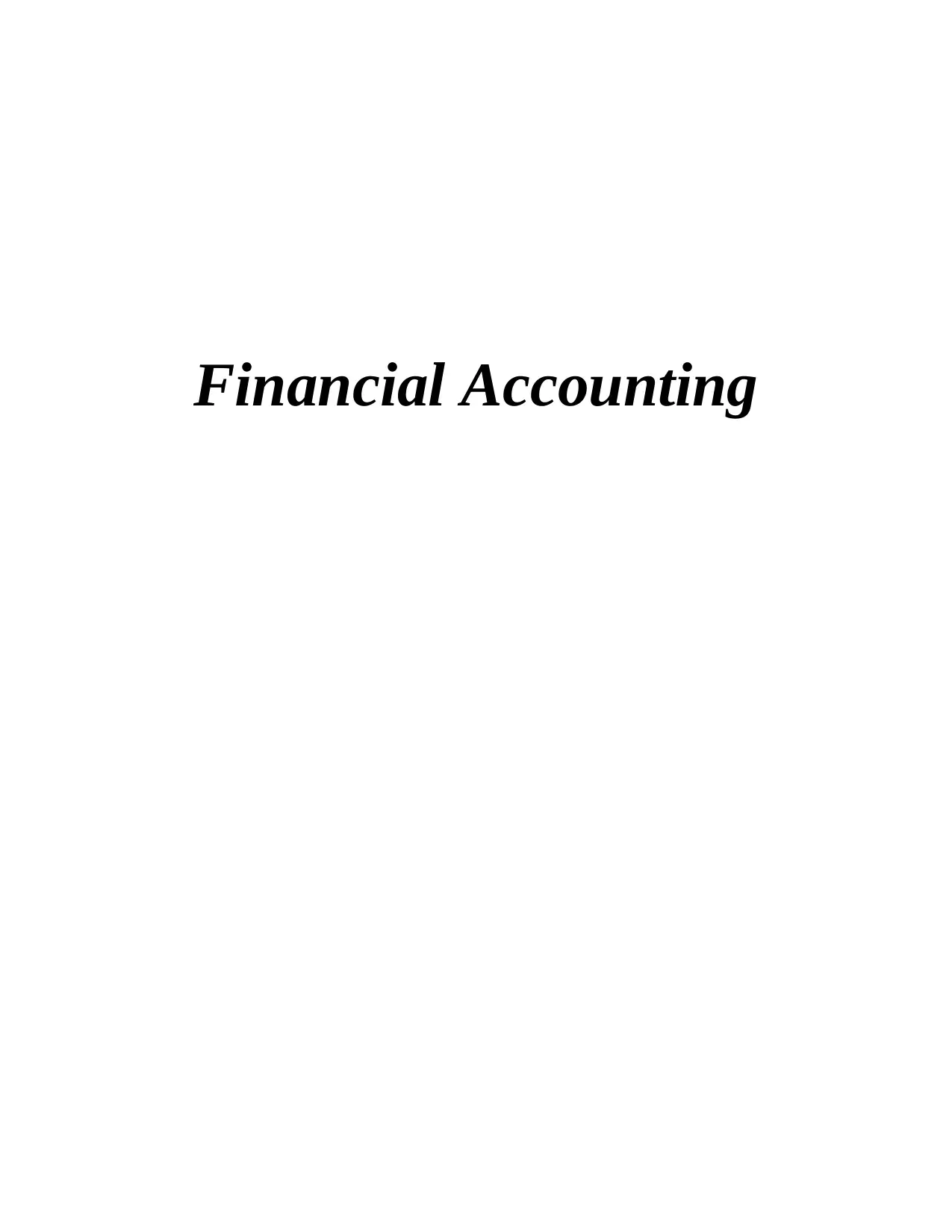
Financial Accounting
Paraphrase This Document
Need a fresh take? Get an instant paraphrase of this document with our AI Paraphraser
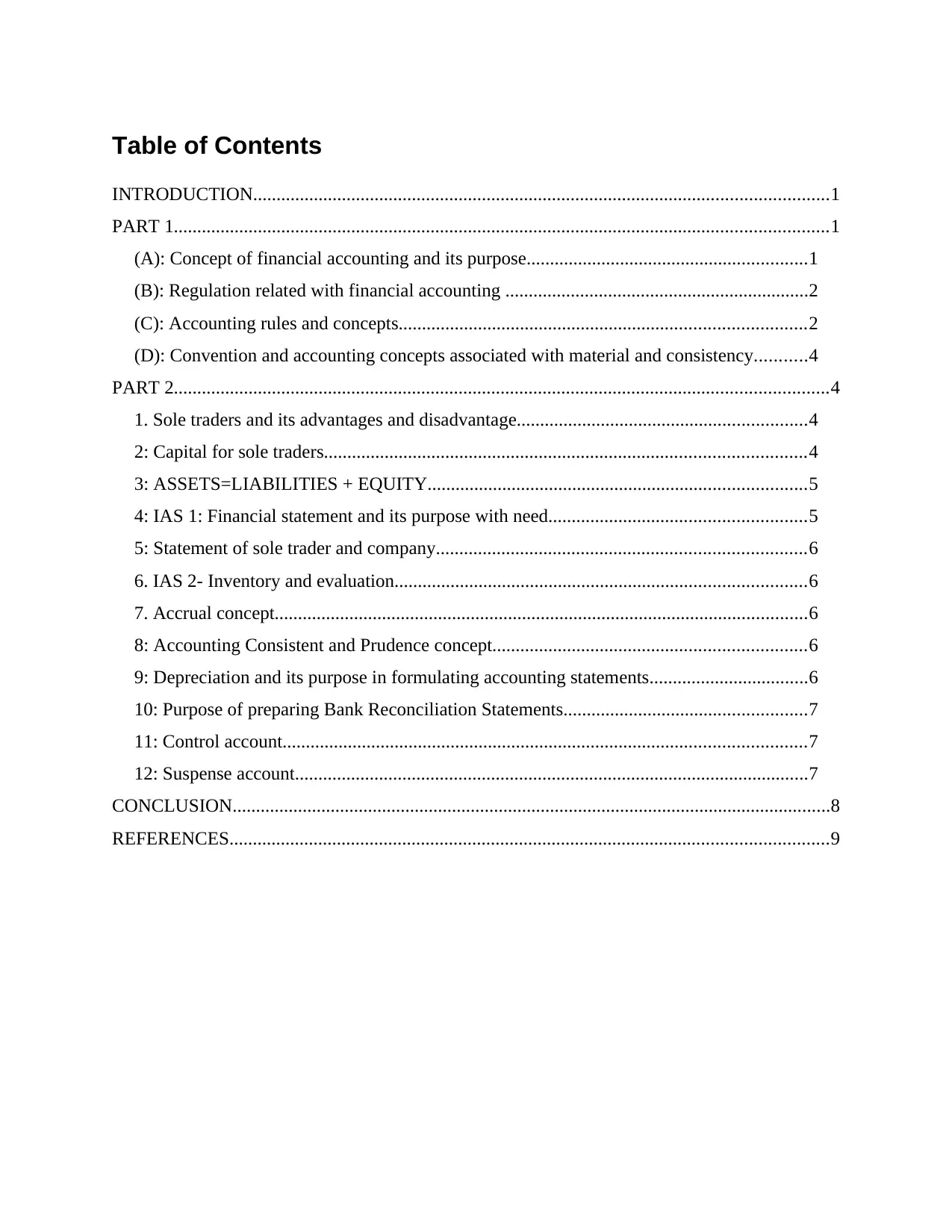
Table of Contents
INTRODUCTION...........................................................................................................................1
PART 1............................................................................................................................................1
(A): Concept of financial accounting and its purpose............................................................1
(B): Regulation related with financial accounting .................................................................2
(C): Accounting rules and concepts.......................................................................................2
(D): Convention and accounting concepts associated with material and consistency...........4
PART 2............................................................................................................................................4
1. Sole traders and its advantages and disadvantage..............................................................4
2: Capital for sole traders.......................................................................................................4
3: ASSETS=LIABILITIES + EQUITY.................................................................................5
4: IAS 1: Financial statement and its purpose with need.......................................................5
5: Statement of sole trader and company...............................................................................6
6. IAS 2- Inventory and evaluation........................................................................................6
7. Accrual concept..................................................................................................................6
8: Accounting Consistent and Prudence concept...................................................................6
9: Depreciation and its purpose in formulating accounting statements..................................6
10: Purpose of preparing Bank Reconciliation Statements....................................................7
11: Control account................................................................................................................7
12: Suspense account..............................................................................................................7
CONCLUSION................................................................................................................................8
REFERENCES................................................................................................................................9
INTRODUCTION...........................................................................................................................1
PART 1............................................................................................................................................1
(A): Concept of financial accounting and its purpose............................................................1
(B): Regulation related with financial accounting .................................................................2
(C): Accounting rules and concepts.......................................................................................2
(D): Convention and accounting concepts associated with material and consistency...........4
PART 2............................................................................................................................................4
1. Sole traders and its advantages and disadvantage..............................................................4
2: Capital for sole traders.......................................................................................................4
3: ASSETS=LIABILITIES + EQUITY.................................................................................5
4: IAS 1: Financial statement and its purpose with need.......................................................5
5: Statement of sole trader and company...............................................................................6
6. IAS 2- Inventory and evaluation........................................................................................6
7. Accrual concept..................................................................................................................6
8: Accounting Consistent and Prudence concept...................................................................6
9: Depreciation and its purpose in formulating accounting statements..................................6
10: Purpose of preparing Bank Reconciliation Statements....................................................7
11: Control account................................................................................................................7
12: Suspense account..............................................................................................................7
CONCLUSION................................................................................................................................8
REFERENCES................................................................................................................................9
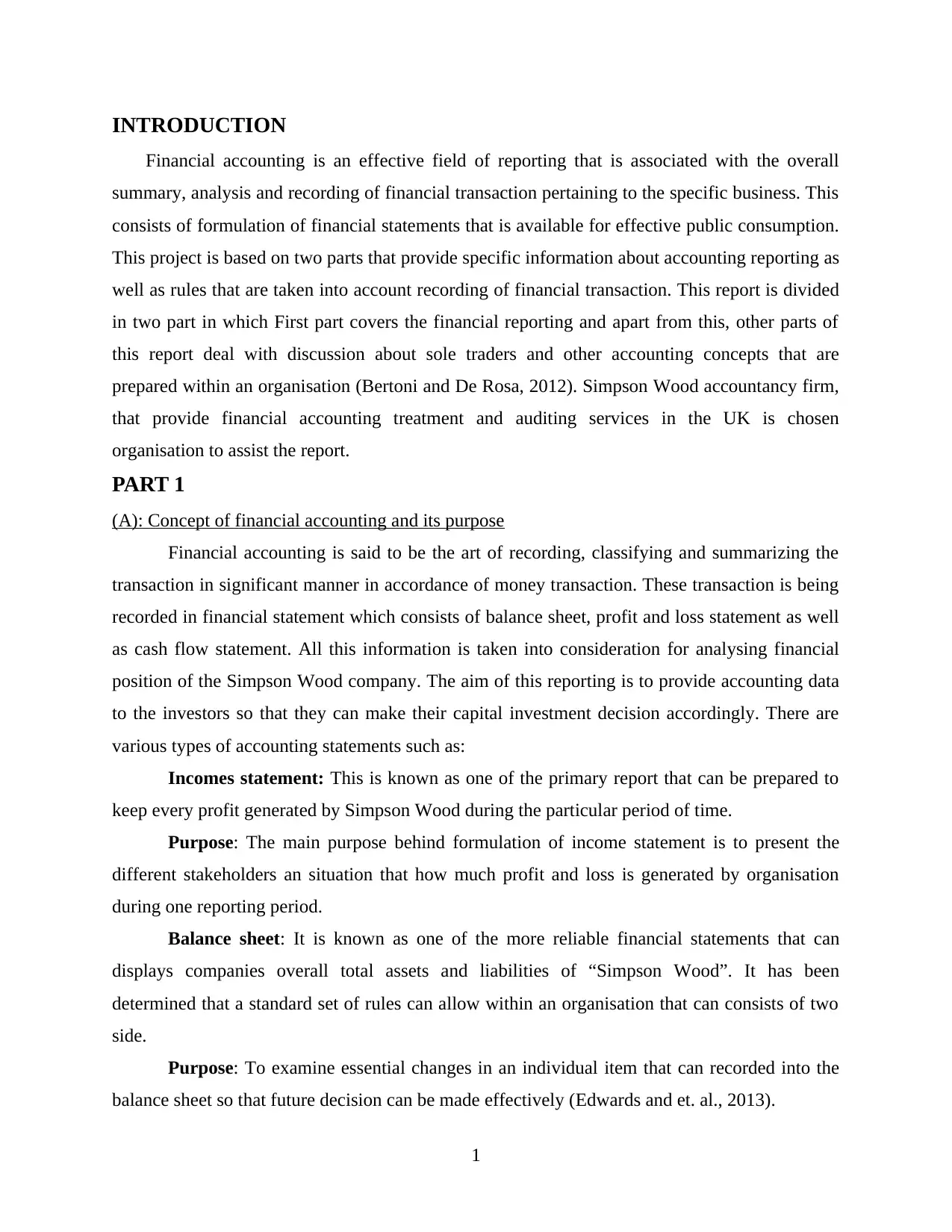
INTRODUCTION
Financial accounting is an effective field of reporting that is associated with the overall
summary, analysis and recording of financial transaction pertaining to the specific business. This
consists of formulation of financial statements that is available for effective public consumption.
This project is based on two parts that provide specific information about accounting reporting as
well as rules that are taken into account recording of financial transaction. This report is divided
in two part in which First part covers the financial reporting and apart from this, other parts of
this report deal with discussion about sole traders and other accounting concepts that are
prepared within an organisation (Bertoni and De Rosa, 2012). Simpson Wood accountancy firm,
that provide financial accounting treatment and auditing services in the UK is chosen
organisation to assist the report.
PART 1
(A): Concept of financial accounting and its purpose
Financial accounting is said to be the art of recording, classifying and summarizing the
transaction in significant manner in accordance of money transaction. These transaction is being
recorded in financial statement which consists of balance sheet, profit and loss statement as well
as cash flow statement. All this information is taken into consideration for analysing financial
position of the Simpson Wood company. The aim of this reporting is to provide accounting data
to the investors so that they can make their capital investment decision accordingly. There are
various types of accounting statements such as:
Incomes statement: This is known as one of the primary report that can be prepared to
keep every profit generated by Simpson Wood during the particular period of time.
Purpose: The main purpose behind formulation of income statement is to present the
different stakeholders an situation that how much profit and loss is generated by organisation
during one reporting period.
Balance sheet: It is known as one of the more reliable financial statements that can
displays companies overall total assets and liabilities of “Simpson Wood”. It has been
determined that a standard set of rules can allow within an organisation that can consists of two
side.
Purpose: To examine essential changes in an individual item that can recorded into the
balance sheet so that future decision can be made effectively (Edwards and et. al., 2013).
1
Financial accounting is an effective field of reporting that is associated with the overall
summary, analysis and recording of financial transaction pertaining to the specific business. This
consists of formulation of financial statements that is available for effective public consumption.
This project is based on two parts that provide specific information about accounting reporting as
well as rules that are taken into account recording of financial transaction. This report is divided
in two part in which First part covers the financial reporting and apart from this, other parts of
this report deal with discussion about sole traders and other accounting concepts that are
prepared within an organisation (Bertoni and De Rosa, 2012). Simpson Wood accountancy firm,
that provide financial accounting treatment and auditing services in the UK is chosen
organisation to assist the report.
PART 1
(A): Concept of financial accounting and its purpose
Financial accounting is said to be the art of recording, classifying and summarizing the
transaction in significant manner in accordance of money transaction. These transaction is being
recorded in financial statement which consists of balance sheet, profit and loss statement as well
as cash flow statement. All this information is taken into consideration for analysing financial
position of the Simpson Wood company. The aim of this reporting is to provide accounting data
to the investors so that they can make their capital investment decision accordingly. There are
various types of accounting statements such as:
Incomes statement: This is known as one of the primary report that can be prepared to
keep every profit generated by Simpson Wood during the particular period of time.
Purpose: The main purpose behind formulation of income statement is to present the
different stakeholders an situation that how much profit and loss is generated by organisation
during one reporting period.
Balance sheet: It is known as one of the more reliable financial statements that can
displays companies overall total assets and liabilities of “Simpson Wood”. It has been
determined that a standard set of rules can allow within an organisation that can consists of two
side.
Purpose: To examine essential changes in an individual item that can recorded into the
balance sheet so that future decision can be made effectively (Edwards and et. al., 2013).
1
⊘ This is a preview!⊘
Do you want full access?
Subscribe today to unlock all pages.

Trusted by 1+ million students worldwide
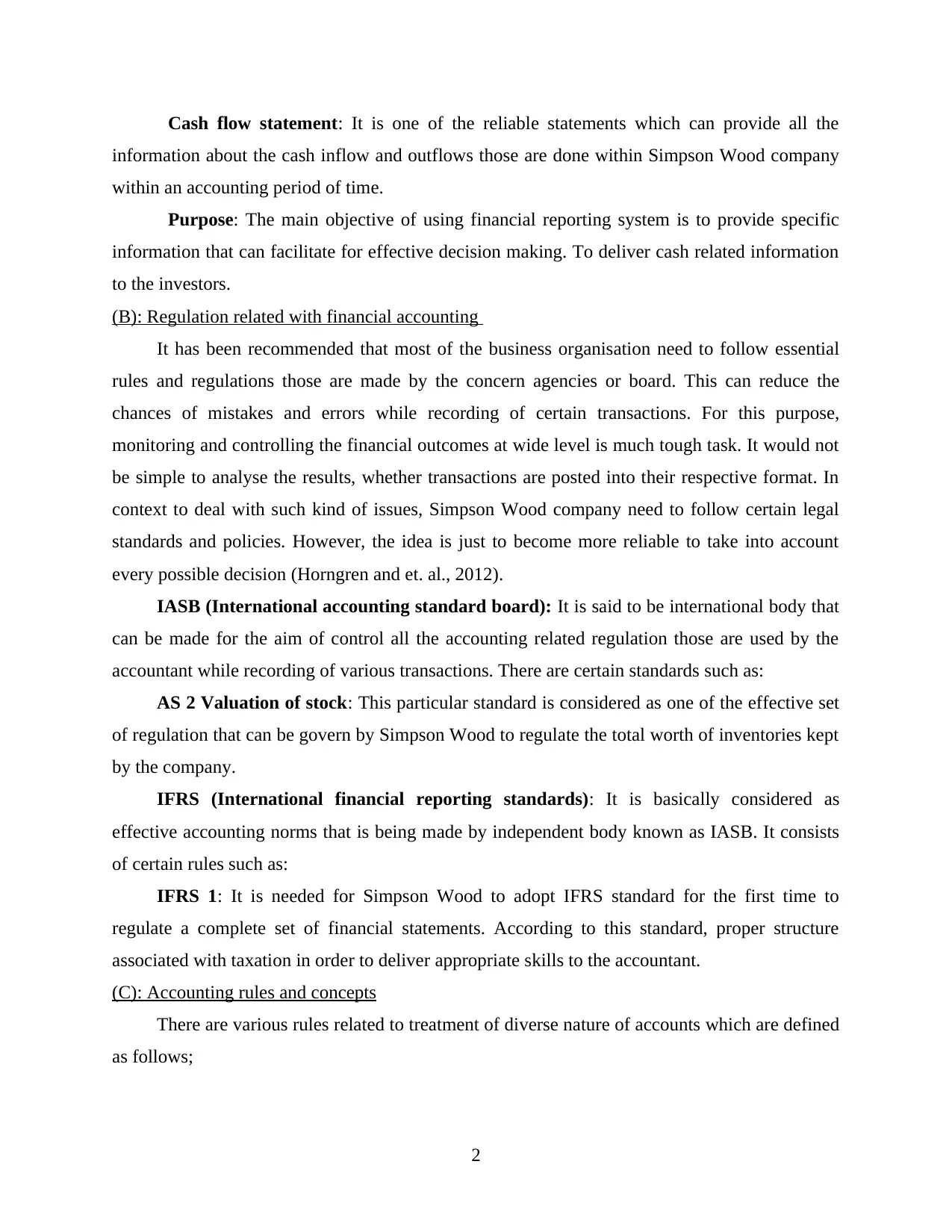
Cash flow statement: It is one of the reliable statements which can provide all the
information about the cash inflow and outflows those are done within Simpson Wood company
within an accounting period of time.
Purpose: The main objective of using financial reporting system is to provide specific
information that can facilitate for effective decision making. To deliver cash related information
to the investors.
(B): Regulation related with financial accounting
It has been recommended that most of the business organisation need to follow essential
rules and regulations those are made by the concern agencies or board. This can reduce the
chances of mistakes and errors while recording of certain transactions. For this purpose,
monitoring and controlling the financial outcomes at wide level is much tough task. It would not
be simple to analyse the results, whether transactions are posted into their respective format. In
context to deal with such kind of issues, Simpson Wood company need to follow certain legal
standards and policies. However, the idea is just to become more reliable to take into account
every possible decision (Horngren and et. al., 2012).
IASB (International accounting standard board): It is said to be international body that
can be made for the aim of control all the accounting related regulation those are used by the
accountant while recording of various transactions. There are certain standards such as:
AS 2 Valuation of stock: This particular standard is considered as one of the effective set
of regulation that can be govern by Simpson Wood to regulate the total worth of inventories kept
by the company.
IFRS (International financial reporting standards): It is basically considered as
effective accounting norms that is being made by independent body known as IASB. It consists
of certain rules such as:
IFRS 1: It is needed for Simpson Wood to adopt IFRS standard for the first time to
regulate a complete set of financial statements. According to this standard, proper structure
associated with taxation in order to deliver appropriate skills to the accountant.
(C): Accounting rules and concepts
There are various rules related to treatment of diverse nature of accounts which are defined
as follows;
2
information about the cash inflow and outflows those are done within Simpson Wood company
within an accounting period of time.
Purpose: The main objective of using financial reporting system is to provide specific
information that can facilitate for effective decision making. To deliver cash related information
to the investors.
(B): Regulation related with financial accounting
It has been recommended that most of the business organisation need to follow essential
rules and regulations those are made by the concern agencies or board. This can reduce the
chances of mistakes and errors while recording of certain transactions. For this purpose,
monitoring and controlling the financial outcomes at wide level is much tough task. It would not
be simple to analyse the results, whether transactions are posted into their respective format. In
context to deal with such kind of issues, Simpson Wood company need to follow certain legal
standards and policies. However, the idea is just to become more reliable to take into account
every possible decision (Horngren and et. al., 2012).
IASB (International accounting standard board): It is said to be international body that
can be made for the aim of control all the accounting related regulation those are used by the
accountant while recording of various transactions. There are certain standards such as:
AS 2 Valuation of stock: This particular standard is considered as one of the effective set
of regulation that can be govern by Simpson Wood to regulate the total worth of inventories kept
by the company.
IFRS (International financial reporting standards): It is basically considered as
effective accounting norms that is being made by independent body known as IASB. It consists
of certain rules such as:
IFRS 1: It is needed for Simpson Wood to adopt IFRS standard for the first time to
regulate a complete set of financial statements. According to this standard, proper structure
associated with taxation in order to deliver appropriate skills to the accountant.
(C): Accounting rules and concepts
There are various rules related to treatment of diverse nature of accounts which are defined
as follows;
2
Paraphrase This Document
Need a fresh take? Get an instant paraphrase of this document with our AI Paraphraser
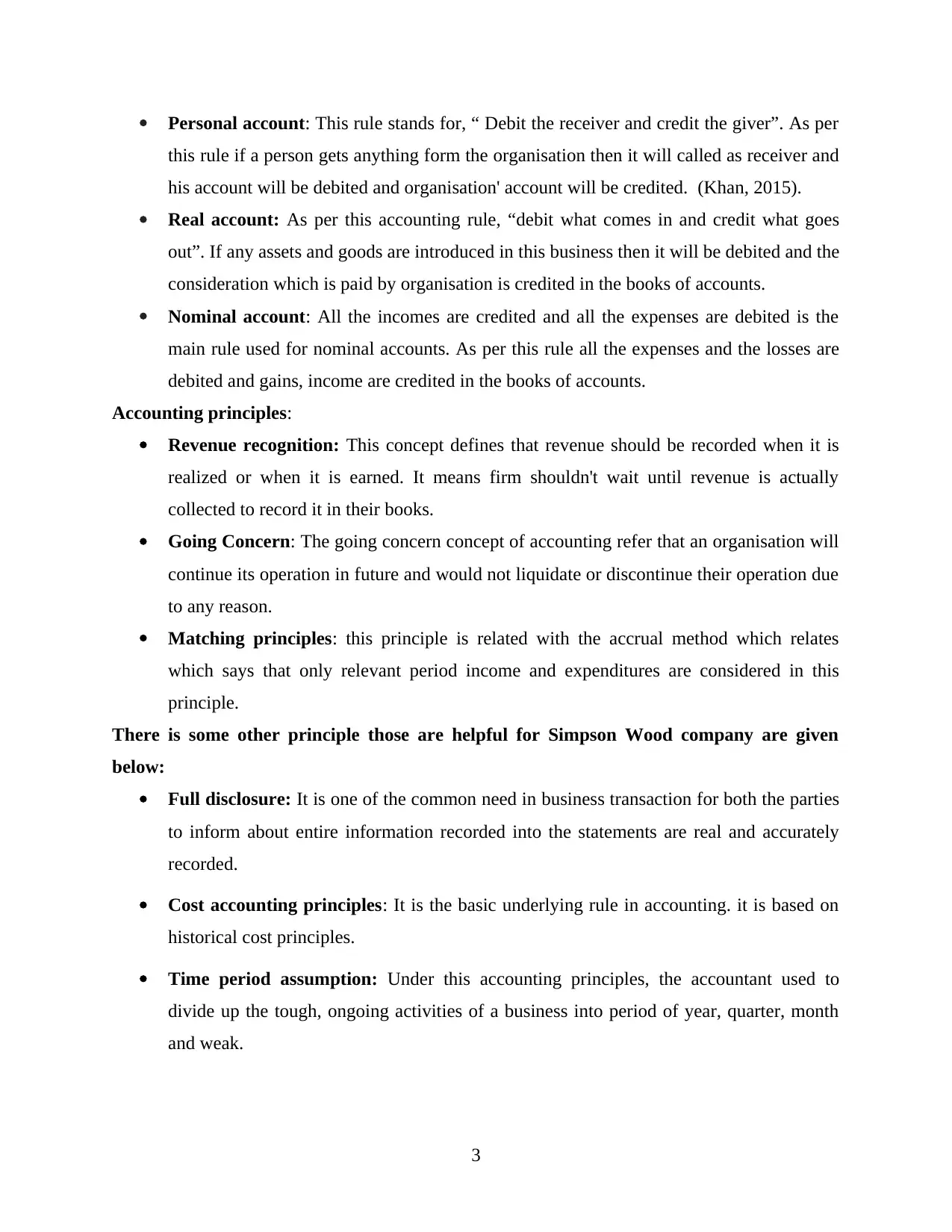
Personal account: This rule stands for, “ Debit the receiver and credit the giver”. As per
this rule if a person gets anything form the organisation then it will called as receiver and
his account will be debited and organisation' account will be credited. (Khan, 2015).
Real account: As per this accounting rule, “debit what comes in and credit what goes
out”. If any assets and goods are introduced in this business then it will be debited and the
consideration which is paid by organisation is credited in the books of accounts.
Nominal account: All the incomes are credited and all the expenses are debited is the
main rule used for nominal accounts. As per this rule all the expenses and the losses are
debited and gains, income are credited in the books of accounts.
Accounting principles:
Revenue recognition: This concept defines that revenue should be recorded when it is
realized or when it is earned. It means firm shouldn't wait until revenue is actually
collected to record it in their books.
Going Concern: The going concern concept of accounting refer that an organisation will
continue its operation in future and would not liquidate or discontinue their operation due
to any reason.
Matching principles: this principle is related with the accrual method which relates
which says that only relevant period income and expenditures are considered in this
principle.
There is some other principle those are helpful for Simpson Wood company are given
below:
Full disclosure: It is one of the common need in business transaction for both the parties
to inform about entire information recorded into the statements are real and accurately
recorded.
Cost accounting principles: It is the basic underlying rule in accounting. it is based on
historical cost principles.
Time period assumption: Under this accounting principles, the accountant used to
divide up the tough, ongoing activities of a business into period of year, quarter, month
and weak.
3
this rule if a person gets anything form the organisation then it will called as receiver and
his account will be debited and organisation' account will be credited. (Khan, 2015).
Real account: As per this accounting rule, “debit what comes in and credit what goes
out”. If any assets and goods are introduced in this business then it will be debited and the
consideration which is paid by organisation is credited in the books of accounts.
Nominal account: All the incomes are credited and all the expenses are debited is the
main rule used for nominal accounts. As per this rule all the expenses and the losses are
debited and gains, income are credited in the books of accounts.
Accounting principles:
Revenue recognition: This concept defines that revenue should be recorded when it is
realized or when it is earned. It means firm shouldn't wait until revenue is actually
collected to record it in their books.
Going Concern: The going concern concept of accounting refer that an organisation will
continue its operation in future and would not liquidate or discontinue their operation due
to any reason.
Matching principles: this principle is related with the accrual method which relates
which says that only relevant period income and expenditures are considered in this
principle.
There is some other principle those are helpful for Simpson Wood company are given
below:
Full disclosure: It is one of the common need in business transaction for both the parties
to inform about entire information recorded into the statements are real and accurately
recorded.
Cost accounting principles: It is the basic underlying rule in accounting. it is based on
historical cost principles.
Time period assumption: Under this accounting principles, the accountant used to
divide up the tough, ongoing activities of a business into period of year, quarter, month
and weak.
3
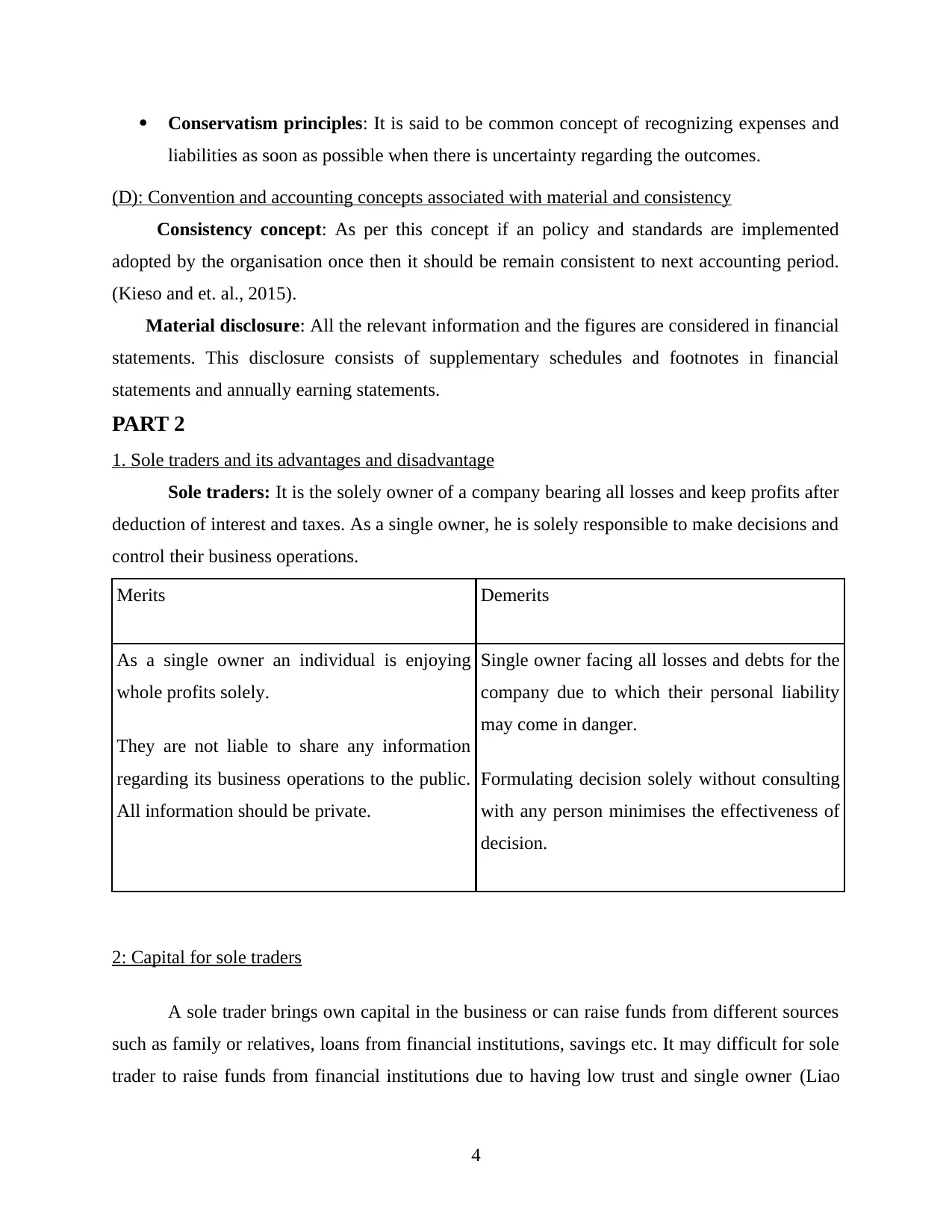
Conservatism principles: It is said to be common concept of recognizing expenses and
liabilities as soon as possible when there is uncertainty regarding the outcomes.
(D): Convention and accounting concepts associated with material and consistency
Consistency concept: As per this concept if an policy and standards are implemented
adopted by the organisation once then it should be remain consistent to next accounting period.
(Kieso and et. al., 2015).
Material disclosure: All the relevant information and the figures are considered in financial
statements. This disclosure consists of supplementary schedules and footnotes in financial
statements and annually earning statements.
PART 2
1. Sole traders and its advantages and disadvantage
Sole traders: It is the solely owner of a company bearing all losses and keep profits after
deduction of interest and taxes. As a single owner, he is solely responsible to make decisions and
control their business operations.
Merits Demerits
As a single owner an individual is enjoying
whole profits solely.
They are not liable to share any information
regarding its business operations to the public.
All information should be private.
Single owner facing all losses and debts for the
company due to which their personal liability
may come in danger.
Formulating decision solely without consulting
with any person minimises the effectiveness of
decision.
2: Capital for sole traders
A sole trader brings own capital in the business or can raise funds from different sources
such as family or relatives, loans from financial institutions, savings etc. It may difficult for sole
trader to raise funds from financial institutions due to having low trust and single owner (Liao
4
liabilities as soon as possible when there is uncertainty regarding the outcomes.
(D): Convention and accounting concepts associated with material and consistency
Consistency concept: As per this concept if an policy and standards are implemented
adopted by the organisation once then it should be remain consistent to next accounting period.
(Kieso and et. al., 2015).
Material disclosure: All the relevant information and the figures are considered in financial
statements. This disclosure consists of supplementary schedules and footnotes in financial
statements and annually earning statements.
PART 2
1. Sole traders and its advantages and disadvantage
Sole traders: It is the solely owner of a company bearing all losses and keep profits after
deduction of interest and taxes. As a single owner, he is solely responsible to make decisions and
control their business operations.
Merits Demerits
As a single owner an individual is enjoying
whole profits solely.
They are not liable to share any information
regarding its business operations to the public.
All information should be private.
Single owner facing all losses and debts for the
company due to which their personal liability
may come in danger.
Formulating decision solely without consulting
with any person minimises the effectiveness of
decision.
2: Capital for sole traders
A sole trader brings own capital in the business or can raise funds from different sources
such as family or relatives, loans from financial institutions, savings etc. It may difficult for sole
trader to raise funds from financial institutions due to having low trust and single owner (Liao
4
⊘ This is a preview!⊘
Do you want full access?
Subscribe today to unlock all pages.

Trusted by 1+ million students worldwide
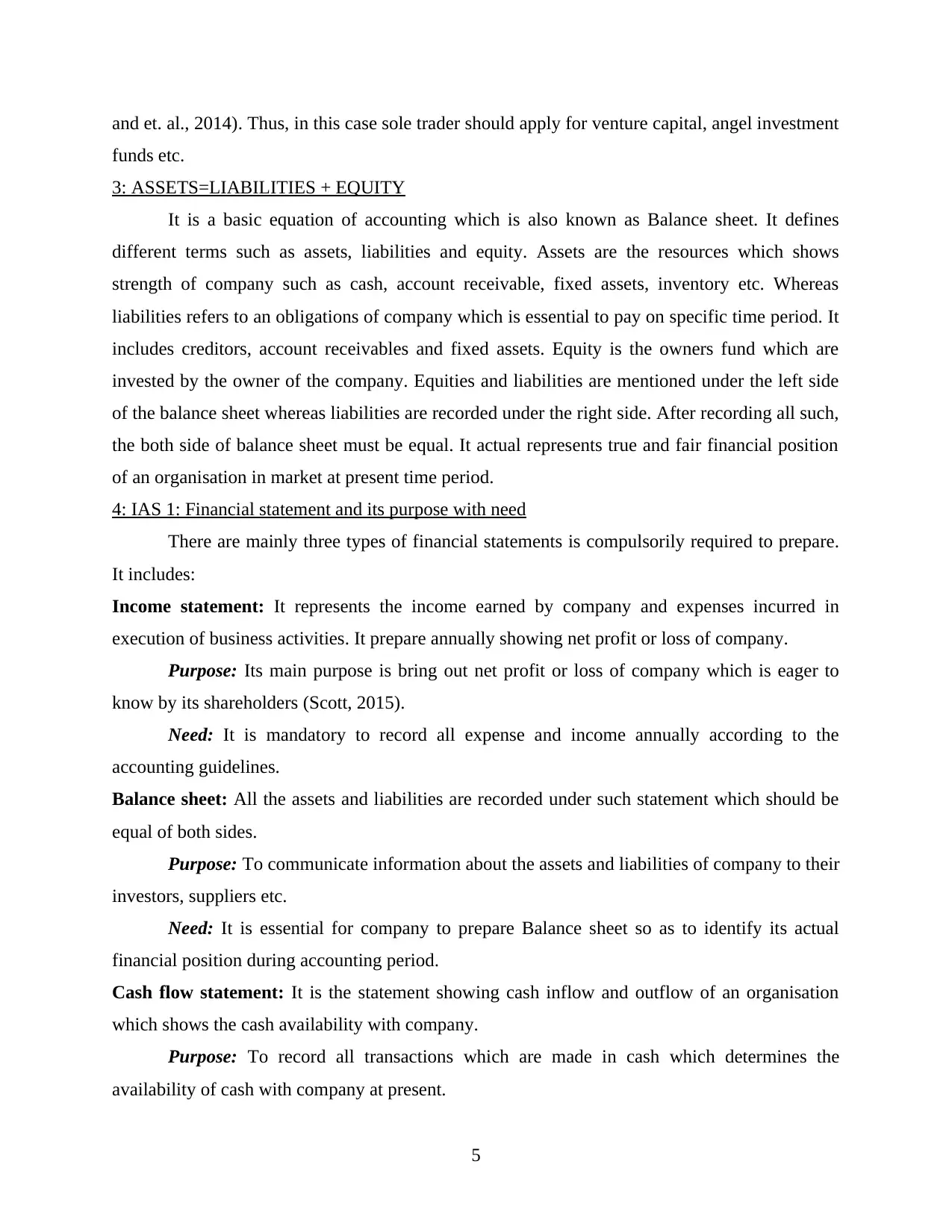
and et. al., 2014). Thus, in this case sole trader should apply for venture capital, angel investment
funds etc.
3: ASSETS=LIABILITIES + EQUITY
It is a basic equation of accounting which is also known as Balance sheet. It defines
different terms such as assets, liabilities and equity. Assets are the resources which shows
strength of company such as cash, account receivable, fixed assets, inventory etc. Whereas
liabilities refers to an obligations of company which is essential to pay on specific time period. It
includes creditors, account receivables and fixed assets. Equity is the owners fund which are
invested by the owner of the company. Equities and liabilities are mentioned under the left side
of the balance sheet whereas liabilities are recorded under the right side. After recording all such,
the both side of balance sheet must be equal. It actual represents true and fair financial position
of an organisation in market at present time period.
4: IAS 1: Financial statement and its purpose with need
There are mainly three types of financial statements is compulsorily required to prepare.
It includes:
Income statement: It represents the income earned by company and expenses incurred in
execution of business activities. It prepare annually showing net profit or loss of company.
Purpose: Its main purpose is bring out net profit or loss of company which is eager to
know by its shareholders (Scott, 2015).
Need: It is mandatory to record all expense and income annually according to the
accounting guidelines.
Balance sheet: All the assets and liabilities are recorded under such statement which should be
equal of both sides.
Purpose: To communicate information about the assets and liabilities of company to their
investors, suppliers etc.
Need: It is essential for company to prepare Balance sheet so as to identify its actual
financial position during accounting period.
Cash flow statement: It is the statement showing cash inflow and outflow of an organisation
which shows the cash availability with company.
Purpose: To record all transactions which are made in cash which determines the
availability of cash with company at present.
5
funds etc.
3: ASSETS=LIABILITIES + EQUITY
It is a basic equation of accounting which is also known as Balance sheet. It defines
different terms such as assets, liabilities and equity. Assets are the resources which shows
strength of company such as cash, account receivable, fixed assets, inventory etc. Whereas
liabilities refers to an obligations of company which is essential to pay on specific time period. It
includes creditors, account receivables and fixed assets. Equity is the owners fund which are
invested by the owner of the company. Equities and liabilities are mentioned under the left side
of the balance sheet whereas liabilities are recorded under the right side. After recording all such,
the both side of balance sheet must be equal. It actual represents true and fair financial position
of an organisation in market at present time period.
4: IAS 1: Financial statement and its purpose with need
There are mainly three types of financial statements is compulsorily required to prepare.
It includes:
Income statement: It represents the income earned by company and expenses incurred in
execution of business activities. It prepare annually showing net profit or loss of company.
Purpose: Its main purpose is bring out net profit or loss of company which is eager to
know by its shareholders (Scott, 2015).
Need: It is mandatory to record all expense and income annually according to the
accounting guidelines.
Balance sheet: All the assets and liabilities are recorded under such statement which should be
equal of both sides.
Purpose: To communicate information about the assets and liabilities of company to their
investors, suppliers etc.
Need: It is essential for company to prepare Balance sheet so as to identify its actual
financial position during accounting period.
Cash flow statement: It is the statement showing cash inflow and outflow of an organisation
which shows the cash availability with company.
Purpose: To record all transactions which are made in cash which determines the
availability of cash with company at present.
5
Paraphrase This Document
Need a fresh take? Get an instant paraphrase of this document with our AI Paraphraser
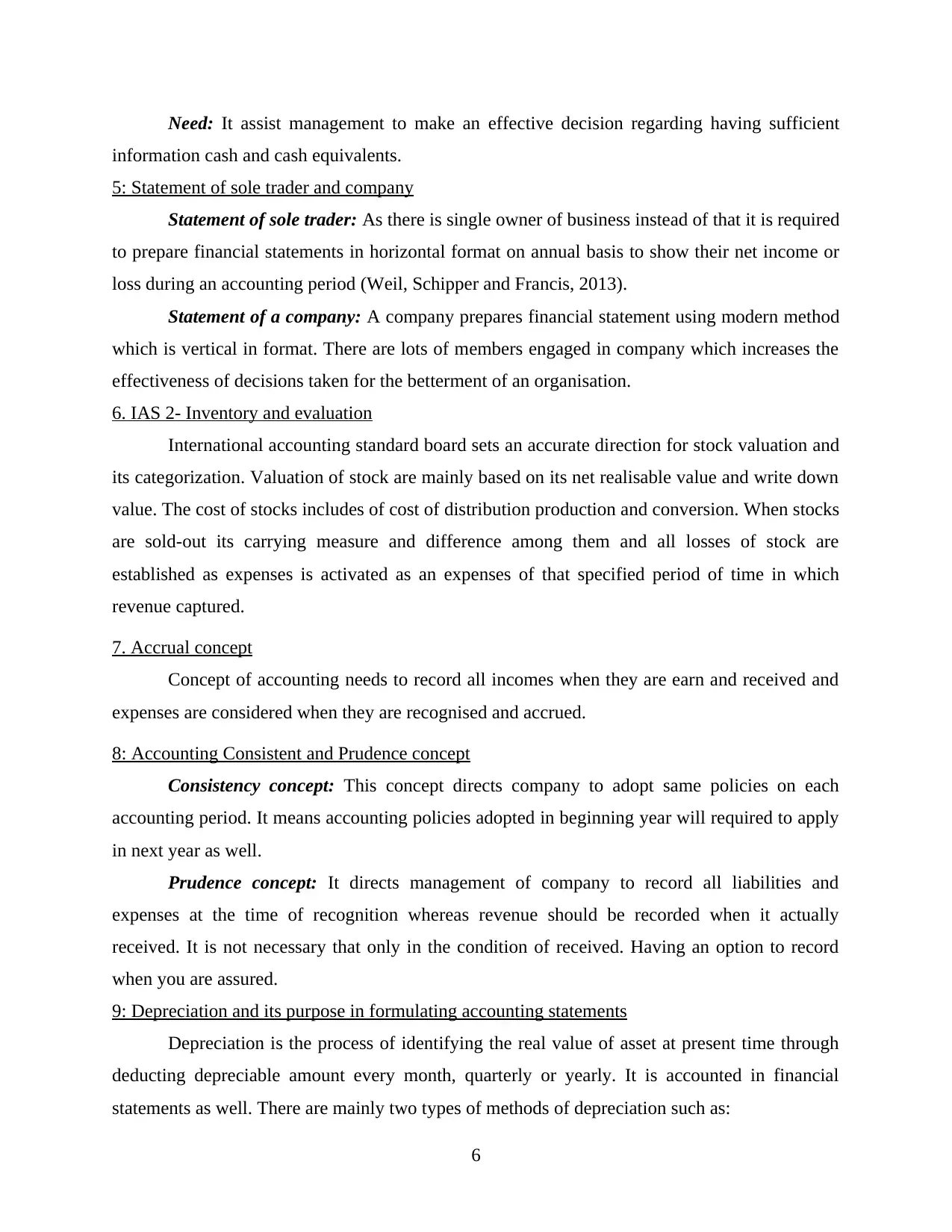
Need: It assist management to make an effective decision regarding having sufficient
information cash and cash equivalents.
5: Statement of sole trader and company
Statement of sole trader: As there is single owner of business instead of that it is required
to prepare financial statements in horizontal format on annual basis to show their net income or
loss during an accounting period (Weil, Schipper and Francis, 2013).
Statement of a company: A company prepares financial statement using modern method
which is vertical in format. There are lots of members engaged in company which increases the
effectiveness of decisions taken for the betterment of an organisation.
6. IAS 2- Inventory and evaluation
International accounting standard board sets an accurate direction for stock valuation and
its categorization. Valuation of stock are mainly based on its net realisable value and write down
value. The cost of stocks includes of cost of distribution production and conversion. When stocks
are sold-out its carrying measure and difference among them and all losses of stock are
established as expenses is activated as an expenses of that specified period of time in which
revenue captured.
7. Accrual concept
Concept of accounting needs to record all incomes when they are earn and received and
expenses are considered when they are recognised and accrued.
8: Accounting Consistent and Prudence concept
Consistency concept: This concept directs company to adopt same policies on each
accounting period. It means accounting policies adopted in beginning year will required to apply
in next year as well.
Prudence concept: It directs management of company to record all liabilities and
expenses at the time of recognition whereas revenue should be recorded when it actually
received. It is not necessary that only in the condition of received. Having an option to record
when you are assured.
9: Depreciation and its purpose in formulating accounting statements
Depreciation is the process of identifying the real value of asset at present time through
deducting depreciable amount every month, quarterly or yearly. It is accounted in financial
statements as well. There are mainly two types of methods of depreciation such as:
6
information cash and cash equivalents.
5: Statement of sole trader and company
Statement of sole trader: As there is single owner of business instead of that it is required
to prepare financial statements in horizontal format on annual basis to show their net income or
loss during an accounting period (Weil, Schipper and Francis, 2013).
Statement of a company: A company prepares financial statement using modern method
which is vertical in format. There are lots of members engaged in company which increases the
effectiveness of decisions taken for the betterment of an organisation.
6. IAS 2- Inventory and evaluation
International accounting standard board sets an accurate direction for stock valuation and
its categorization. Valuation of stock are mainly based on its net realisable value and write down
value. The cost of stocks includes of cost of distribution production and conversion. When stocks
are sold-out its carrying measure and difference among them and all losses of stock are
established as expenses is activated as an expenses of that specified period of time in which
revenue captured.
7. Accrual concept
Concept of accounting needs to record all incomes when they are earn and received and
expenses are considered when they are recognised and accrued.
8: Accounting Consistent and Prudence concept
Consistency concept: This concept directs company to adopt same policies on each
accounting period. It means accounting policies adopted in beginning year will required to apply
in next year as well.
Prudence concept: It directs management of company to record all liabilities and
expenses at the time of recognition whereas revenue should be recorded when it actually
received. It is not necessary that only in the condition of received. Having an option to record
when you are assured.
9: Depreciation and its purpose in formulating accounting statements
Depreciation is the process of identifying the real value of asset at present time through
deducting depreciable amount every month, quarterly or yearly. It is accounted in financial
statements as well. There are mainly two types of methods of depreciation such as:
6
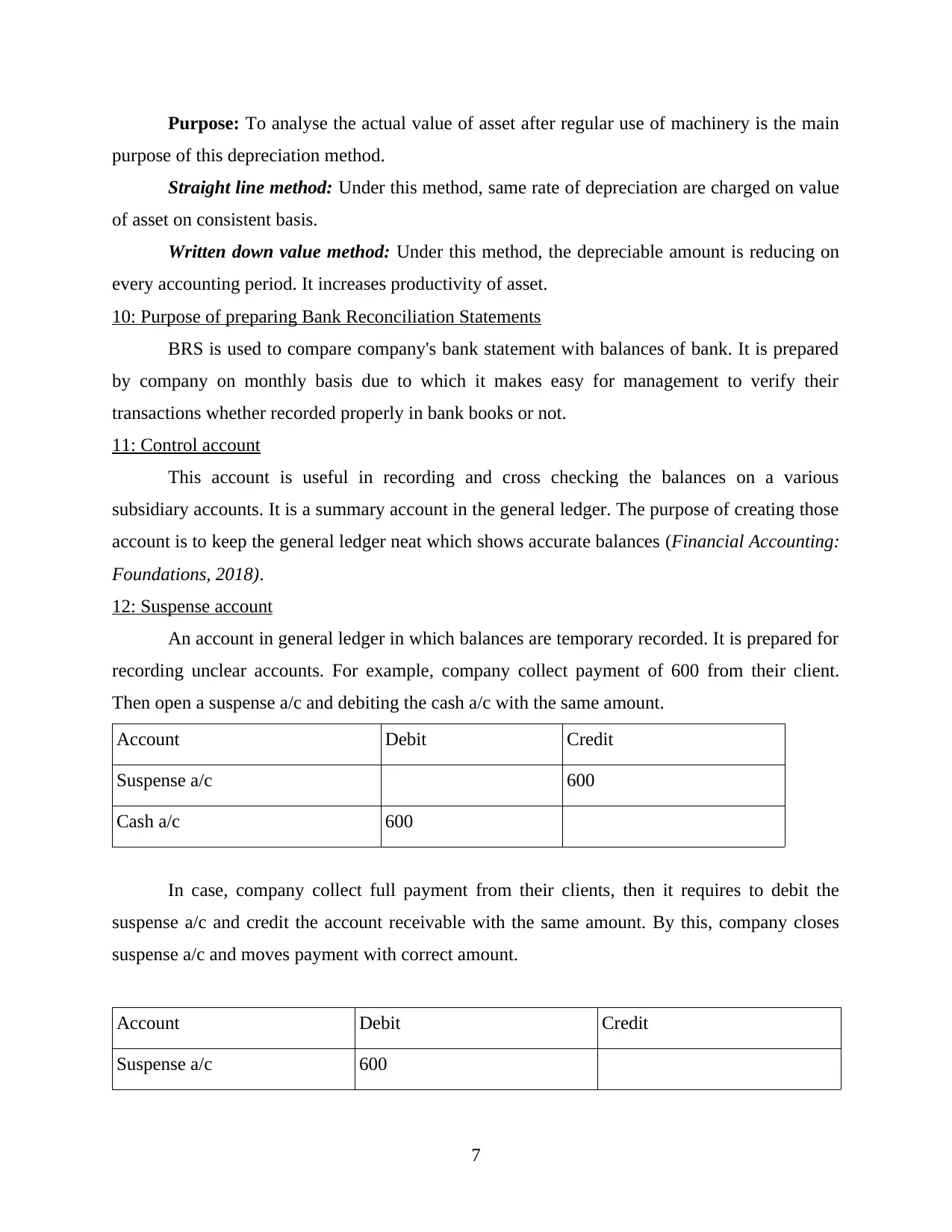
Purpose: To analyse the actual value of asset after regular use of machinery is the main
purpose of this depreciation method.
Straight line method: Under this method, same rate of depreciation are charged on value
of asset on consistent basis.
Written down value method: Under this method, the depreciable amount is reducing on
every accounting period. It increases productivity of asset.
10: Purpose of preparing Bank Reconciliation Statements
BRS is used to compare company's bank statement with balances of bank. It is prepared
by company on monthly basis due to which it makes easy for management to verify their
transactions whether recorded properly in bank books or not.
11: Control account
This account is useful in recording and cross checking the balances on a various
subsidiary accounts. It is a summary account in the general ledger. The purpose of creating those
account is to keep the general ledger neat which shows accurate balances (Financial Accounting:
Foundations, 2018).
12: Suspense account
An account in general ledger in which balances are temporary recorded. It is prepared for
recording unclear accounts. For example, company collect payment of 600 from their client.
Then open a suspense a/c and debiting the cash a/c with the same amount.
Account Debit Credit
Suspense a/c 600
Cash a/c 600
In case, company collect full payment from their clients, then it requires to debit the
suspense a/c and credit the account receivable with the same amount. By this, company closes
suspense a/c and moves payment with correct amount.
Account Debit Credit
Suspense a/c 600
7
purpose of this depreciation method.
Straight line method: Under this method, same rate of depreciation are charged on value
of asset on consistent basis.
Written down value method: Under this method, the depreciable amount is reducing on
every accounting period. It increases productivity of asset.
10: Purpose of preparing Bank Reconciliation Statements
BRS is used to compare company's bank statement with balances of bank. It is prepared
by company on monthly basis due to which it makes easy for management to verify their
transactions whether recorded properly in bank books or not.
11: Control account
This account is useful in recording and cross checking the balances on a various
subsidiary accounts. It is a summary account in the general ledger. The purpose of creating those
account is to keep the general ledger neat which shows accurate balances (Financial Accounting:
Foundations, 2018).
12: Suspense account
An account in general ledger in which balances are temporary recorded. It is prepared for
recording unclear accounts. For example, company collect payment of 600 from their client.
Then open a suspense a/c and debiting the cash a/c with the same amount.
Account Debit Credit
Suspense a/c 600
Cash a/c 600
In case, company collect full payment from their clients, then it requires to debit the
suspense a/c and credit the account receivable with the same amount. By this, company closes
suspense a/c and moves payment with correct amount.
Account Debit Credit
Suspense a/c 600
7
⊘ This is a preview!⊘
Do you want full access?
Subscribe today to unlock all pages.

Trusted by 1+ million students worldwide
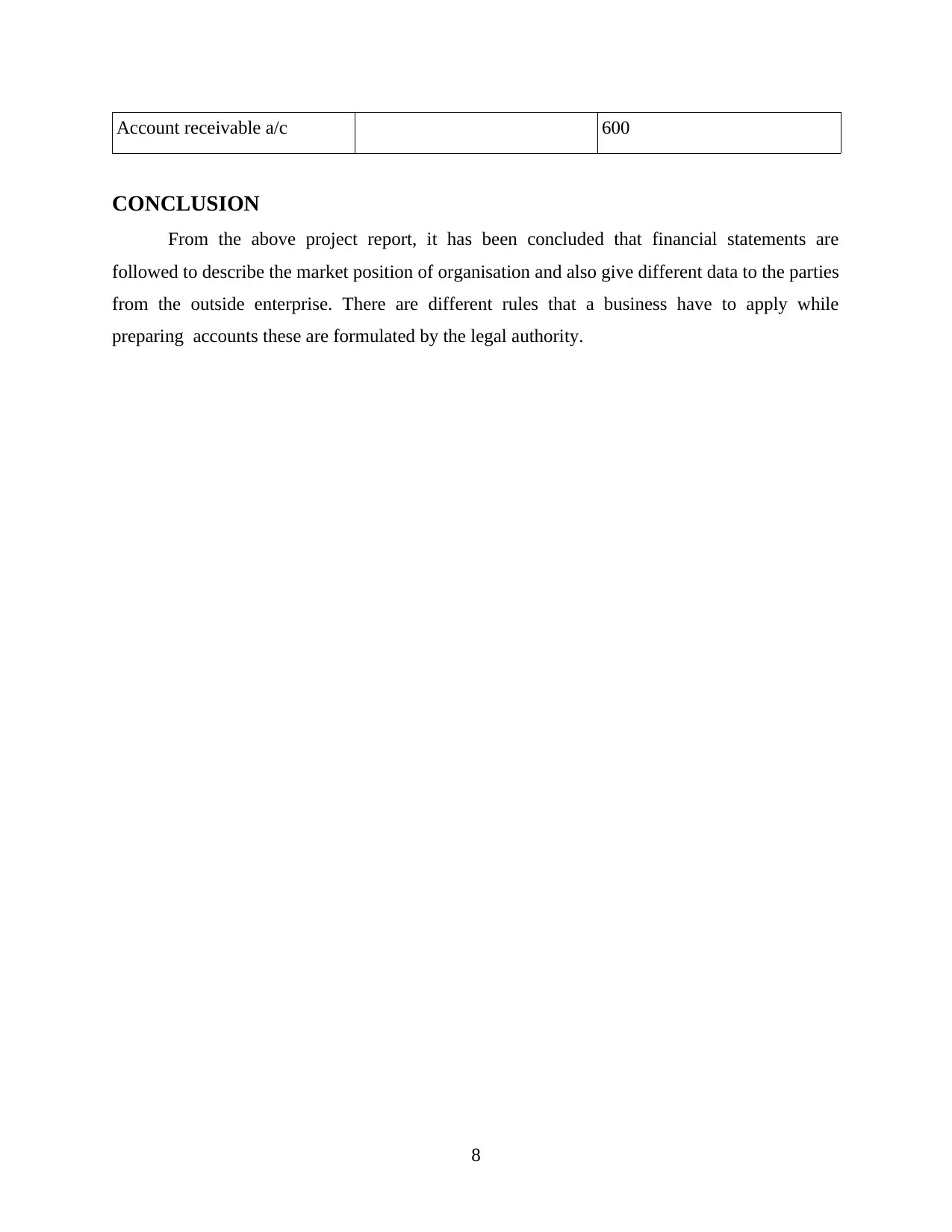
Account receivable a/c 600
CONCLUSION
From the above project report, it has been concluded that financial statements are
followed to describe the market position of organisation and also give different data to the parties
from the outside enterprise. There are different rules that a business have to apply while
preparing accounts these are formulated by the legal authority.
8
CONCLUSION
From the above project report, it has been concluded that financial statements are
followed to describe the market position of organisation and also give different data to the parties
from the outside enterprise. There are different rules that a business have to apply while
preparing accounts these are formulated by the legal authority.
8
Paraphrase This Document
Need a fresh take? Get an instant paraphrase of this document with our AI Paraphraser
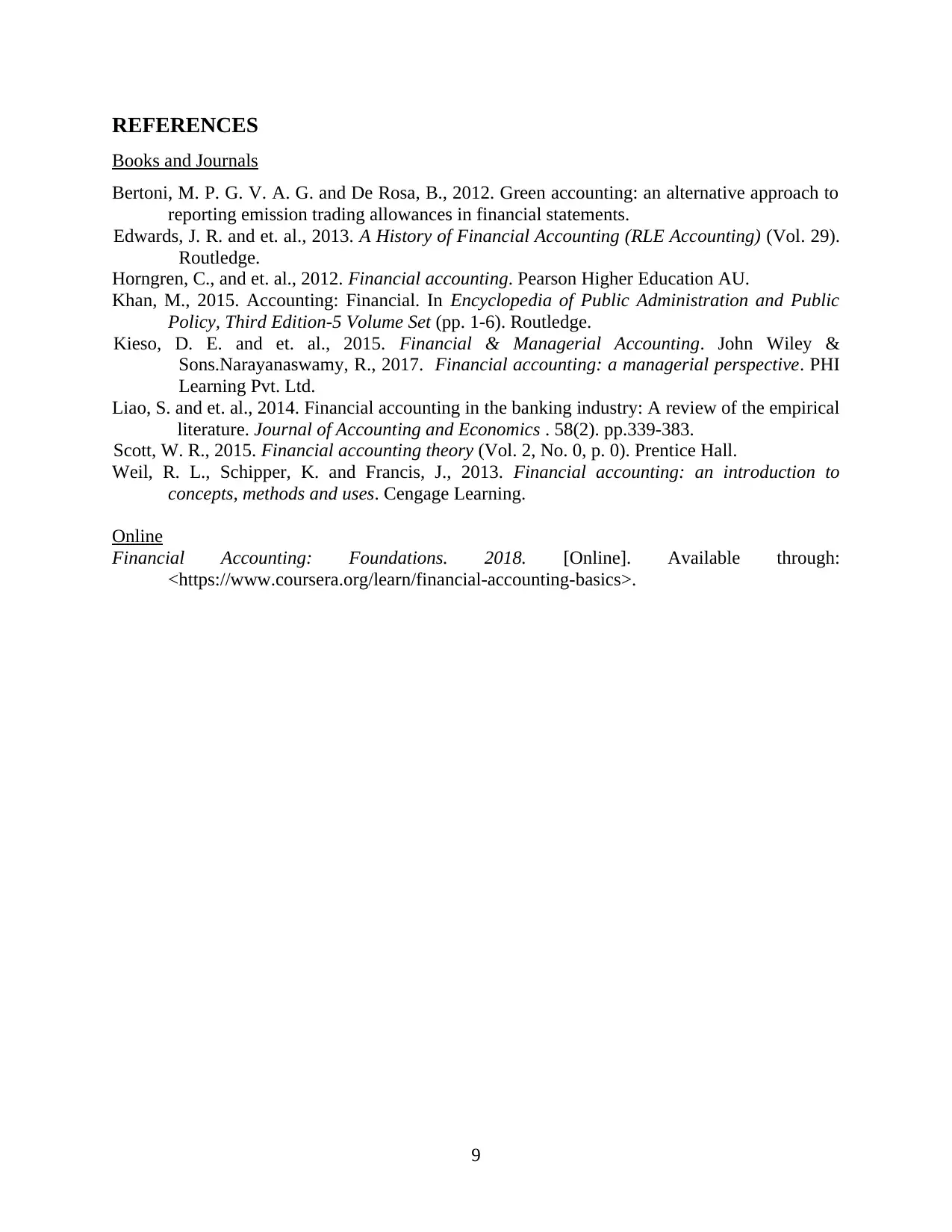
REFERENCES
Books and Journals
Bertoni, M. P. G. V. A. G. and De Rosa, B., 2012. Green accounting: an alternative approach to
reporting emission trading allowances in financial statements.
Edwards, J. R. and et. al., 2013. A History of Financial Accounting (RLE Accounting) (Vol. 29).
Routledge.
Horngren, C., and et. al., 2012. Financial accounting. Pearson Higher Education AU.
Khan, M., 2015. Accounting: Financial. In Encyclopedia of Public Administration and Public
Policy, Third Edition-5 Volume Set (pp. 1-6). Routledge.
Kieso, D. E. and et. al., 2015. Financial & Managerial Accounting. John Wiley &
Sons.Narayanaswamy, R., 2017. Financial accounting: a managerial perspective. PHI
Learning Pvt. Ltd.
Liao, S. and et. al., 2014. Financial accounting in the banking industry: A review of the empirical
literature. Journal of Accounting and Economics . 58(2). pp.339-383.
Scott, W. R., 2015. Financial accounting theory (Vol. 2, No. 0, p. 0). Prentice Hall.
Weil, R. L., Schipper, K. and Francis, J., 2013. Financial accounting: an introduction to
concepts, methods and uses. Cengage Learning.
Online
Financial Accounting: Foundations. 2018. [Online]. Available through:
<https://www.coursera.org/learn/financial-accounting-basics>.
9
Books and Journals
Bertoni, M. P. G. V. A. G. and De Rosa, B., 2012. Green accounting: an alternative approach to
reporting emission trading allowances in financial statements.
Edwards, J. R. and et. al., 2013. A History of Financial Accounting (RLE Accounting) (Vol. 29).
Routledge.
Horngren, C., and et. al., 2012. Financial accounting. Pearson Higher Education AU.
Khan, M., 2015. Accounting: Financial. In Encyclopedia of Public Administration and Public
Policy, Third Edition-5 Volume Set (pp. 1-6). Routledge.
Kieso, D. E. and et. al., 2015. Financial & Managerial Accounting. John Wiley &
Sons.Narayanaswamy, R., 2017. Financial accounting: a managerial perspective. PHI
Learning Pvt. Ltd.
Liao, S. and et. al., 2014. Financial accounting in the banking industry: A review of the empirical
literature. Journal of Accounting and Economics . 58(2). pp.339-383.
Scott, W. R., 2015. Financial accounting theory (Vol. 2, No. 0, p. 0). Prentice Hall.
Weil, R. L., Schipper, K. and Francis, J., 2013. Financial accounting: an introduction to
concepts, methods and uses. Cengage Learning.
Online
Financial Accounting: Foundations. 2018. [Online]. Available through:
<https://www.coursera.org/learn/financial-accounting-basics>.
9
1 out of 11
Related Documents
Your All-in-One AI-Powered Toolkit for Academic Success.
+13062052269
info@desklib.com
Available 24*7 on WhatsApp / Email
![[object Object]](/_next/static/media/star-bottom.7253800d.svg)
Unlock your academic potential
Copyright © 2020–2025 A2Z Services. All Rights Reserved. Developed and managed by ZUCOL.





